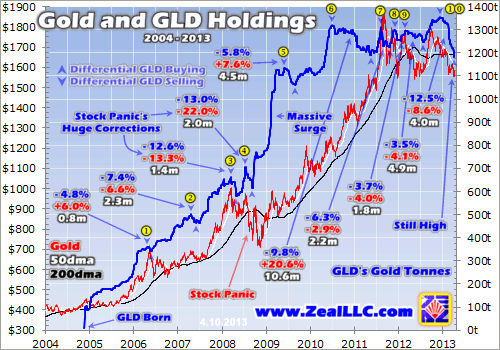ETFs contribute to gold s plunge
Post on: 14 Июль, 2015 No Comment

Story Highlights
- Gold ETFs contribute to the metals rise and plunge One ETF holds more gold than some countries central banks Hedge fund manager John Paulson suffers in the slide
Gold-backed exchange-traded funds (ETFs) helped fuel gold’s historic rally as the ETFs allowed investors and hedge funds to easily buy the precious metal with one click of a mouse.
Now, the ETFs are likely exacerbating the worst two-day fall in 30 years, which has sent the price of gold plunging more than $200 an ounce. The sharp slide has left hedge fund managers like John Paulson smarting, benefited others like billionaire George Soros, and prompted nervous traders and individual investors to dump their holdings.
For example, the amount of gold held by the largest gold exchange-traded fund, SPDR Gold Shares (GLD), on Friday fell below 38 million ounces for the first time since May 2010. And that was before Monday’s massive drop.
The gold ETF’s bullion holdings have declined more than 14% so far this year. Meanwhile, the amount of gold in global exchange traded products has fallen in recent months after hitting a record of more than 80 million ounces.
The fund was seeing additional outflows Monday as gold prices plunged more than $140, as low as $1,355 an ounce at one point. GLD has seen its price decline more than 10% the past two trading sessions. It has seen net outflows of $9.8 billion year to date, the most for any U.S.-listed ETF, according to flow data from IndexUniverse.com.
As of Friday, the gold fund held 1,158.6 metric tons of gold and $57.2 billion of assets under management. Other gold ETFs backed by physical bullion include the $10.4 billion iShares Gold Trust (IAU) and the $1.8 billion ETFS Physical Swiss Gold Shares (SGOL).
It’s difficult to quantify exactly how much the gold ETFs have contributed to the 12-year rally for the precious metal. Prices are driven primarily by sales of jewelry and gold coins and bars, as well as the futures market. GLD was listed in November 2004.
Still, gold ETFs have certainly contributed to gold falling more than 20% from the 2011 all-time highs and into a bear market. For example, GLD controls more gold than most countries’ central banks. And traders can sell ETFs just as easily as they can buy them. This ETF revolving door could contribute to more volatile prices in gold.
Shares of the gold ETF represent about a tenth of an ounce of gold stored in the London vault of banking giant HSBC. The fund is sponsored by a subsidiary of the World Gold Council and is marketed by State Street, one of the world’s largest ETF providers. GLD charges an expense ratio of 0.40%.

For investors who aren’t worried about confiscation or a Mad Max scenario, exchange traded funds are likely the most efficient way to own gold, says Morningstar analyst Samuel Lee.
GLD was intended to offer investors a means of participating in the gold bullion market without the necessity of taking physical delivery of gold, and to buy and sell that participation through the trading of a security on a regulated stock exchange, according to the ETF’s marketing materials. GLD is intended to lower many of the barriers, such as access, custody and transaction costs, that have prevented some investors from investing in gold.
Indeed, gold ETFs have allowed investors of all stripes to buy gold with one trade in their brokerage account, from individuals to pension funds.
For example, Paulson & Co. the hedge fund firm founded by John Paulson, owned nearly 22 million shares of GLD at the end of 2012, unchanged from the previous quarter, according to the most recent regulatory filings. So the recent slide has cost him dearly.
However, legendary hedge fund manager George Soros is looking pretty savvy, having cut his investment in the gold ETF by 55% in the fourth quarter.
Investors shocked by the two-day plunge in gold prices could follow Soros’ lead and sell ETFs, which would only put more pressure on the precious metal.
John Spence is web editor of ETFtrends.com














